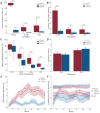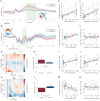Auditory illusory models as proxies to investigate bottom-up and top-down neural networks of phantom perception
- PMID: 40800848
- PMCID: PMC12319843
- DOI: 10.1162/imag_a_00574
Auditory illusory models as proxies to investigate bottom-up and top-down neural networks of phantom perception
Abstract
Auditory phantom perception, exemplified by tinnitus, is characterized by a perceptual experience without external stimuli. This study utilized two auditory illusions, the Zwicker Tone (ZT) and Conditioned Hallucinations (CH), as proxies to investigate the neural correlates of bottom-up and top-down mechanisms underlying phantom auditory perception. Using a within-subject design, ZT, driven by temporary sensory deficits, and CH, influenced by multisensory expectations, were examined in a sample of healthy participants. Electrophysiological measures revealed distinct time-frequency patterns, with increased theta activity in central regions during ZT perception but decreased parietal theta power during CH perception. Key regions in the ZT network, including the medial prefrontal cortex, lateral orbitofrontal cortex, and ventral posterior cingulate cortex, suggested the involvement of the default mode network and predictive processing in compensating for sensory deficits. In contrast, CH perception implicated the parahippocampus, entorhinal cortex, and inferior temporal gyrus in modulating multisensory associations and cognitive expectations. Taken together, this study revealed the neural mechanism of two auditory illusions, which enhances understanding of tinnitus mechanism. The results also highlight potential neural targets for neuromodulation interventions addressing both sensory and cognitive components of chronic phantom perception.
Keywords: auditory illusions; connectivity; phantom perception; theta oscillation; tinnitus.
© 2025 The Authors. Published under a Creative Commons Attribution 4.0 International (CC BY 4.0) license.
Conflict of interest statement
The authors report no potential conflicts of interest.
Figures





References
-
- Aleman , A. , & Vercammen , A. ( 2013. ). The “bottom-up” and “top-down” components of the hallucinatory phenomenon . In Jardri R. , Cachia A. , Thomas P. , & Pins D. (Eds.), The neuroscience of hallucinations (pp. 107 – 121 ). Springer; . 10.1007/978-1-4614-4121-2_6 - DOI
-
- Asko , O. , Blenkmann , A. O. , Leske , S. L. , Foldal , M. D. , LLorens , A. , Funderud , I. , Meling , T. R. , Knight , R. T. , Endestad , T. , & Solbakk , A.-K. ( 2024. ). Altered hierarchical auditory predictive processing after lesions to the orbitofrontal cortex . eLife , 13 , e86386 . 10.7554/eLife.86386 - DOI - PMC - PubMed
LinkOut - more resources
Full Text Sources
